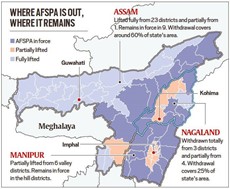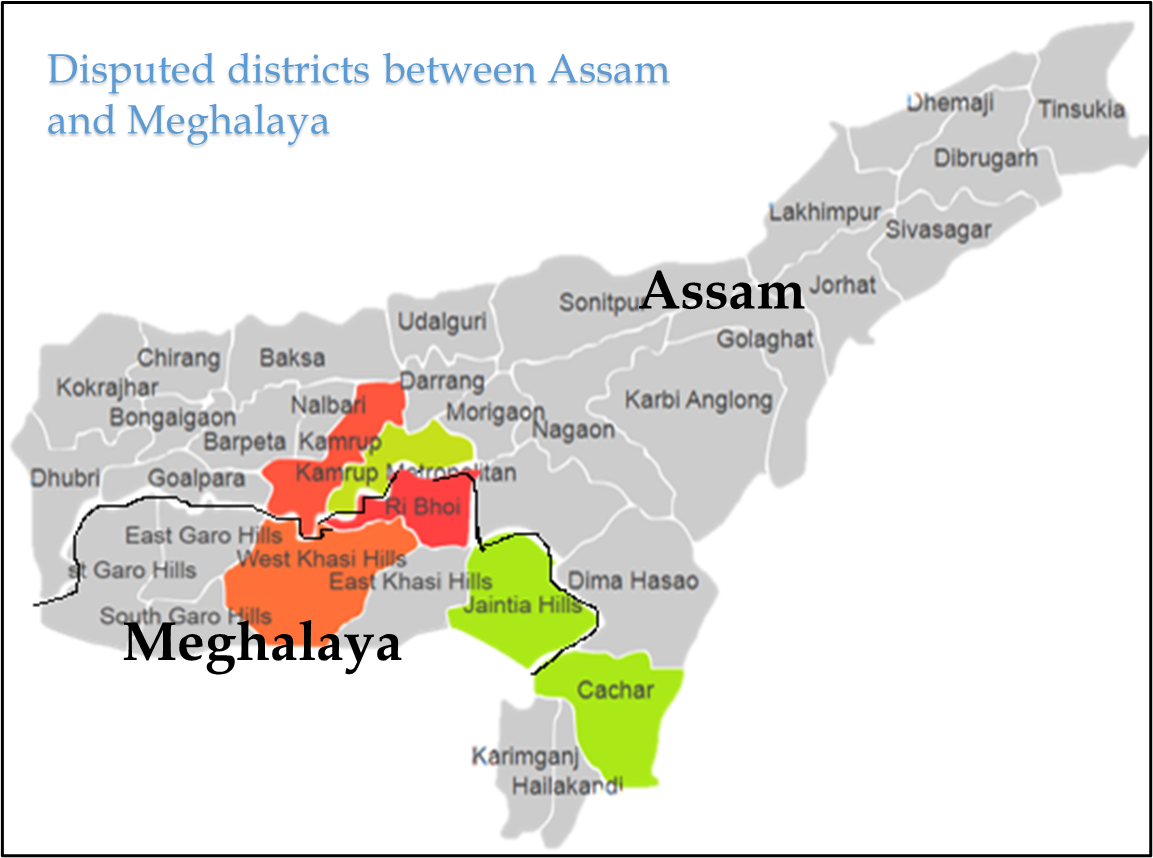Friday, 11th March 2022
National Land Monetization Corporation
In News
The Union Cabinet has recently approved the setting up of the National Land Monetization Corporation (NLMC).
About the news
The National Land Monetization Corporation (NLMC) is being set up to monetise surplus land and building assets of Central Public Sector Enterprises (CPSEs) and other agencies linked to the Government.
National Land Monetization Corporation (NLMC)
- Ownership: It will be fully owned by the Centre, under the administrative jurisdiction of the Finance Ministry
- Capitalization: NLMC will have an initial authorised share capital of Rs 5,000 crore and paid-up share capital of Rs 150 crore.
- Objective: The objective of the corporation is to monetise and generate revenue for the government from unused and under-used non-core assets in the nature of land and buildings
- Railways, Telecommunications and Defence are among key ministries holding the maximum surplus land, while parcels of several CPSEs are in prime areas with good potential.
- For this purpose, the Government had put out a four-year National Monetisation Pipeline (NMP) worth Rs 6 lakh crore of which Roads, Railways and power sector assets will comprise over 66%.
- How NLMC will aid disinvestment: Due to lack of investor’s interest in loss making PSUs, disinvestment target has been lowered. For instance, the set Government target of Rs 1.75 lakh crore through disinvestment in Budget 2021-22, has been revised to Rs 78,000 crore for the year 2022-23
- To fill the gap in the revenue, the government assets have to be monetized which will in turn increase the market value of CPSEs. This will help revive the investor’s interest.
- This is where the NLMC will own, hold, manage and monetise surplus land and building assets of CPSEs under strategic disinvestment.
- Possible challenges for NLMC: Among the key challenges that NLMC might face include:
- Lack of identifiable revenue streams in particular land assets
- Dispute resolution mechanism
- Various litigations and lack of clear titles
- Low interest among investors in remote land parcels.
- Employment Structure of NLMC: NLMC will hire professionals from the private sector as in the case of similar entities like the National Investment and Infrastructure Fund (NIIF) and Invest India.
- This is needed since real estate monetisation requires specialised skills and expertise in areas such as market research, legal due diligence, valuation, master planning, investment banking and land management.
- The Corporation will have minimal full-time staff, hired directly from the market on a contract basis.
- Flexibility will be provided to the Board of NLMC to hire, pay and retain experienced professionals from the private sector.
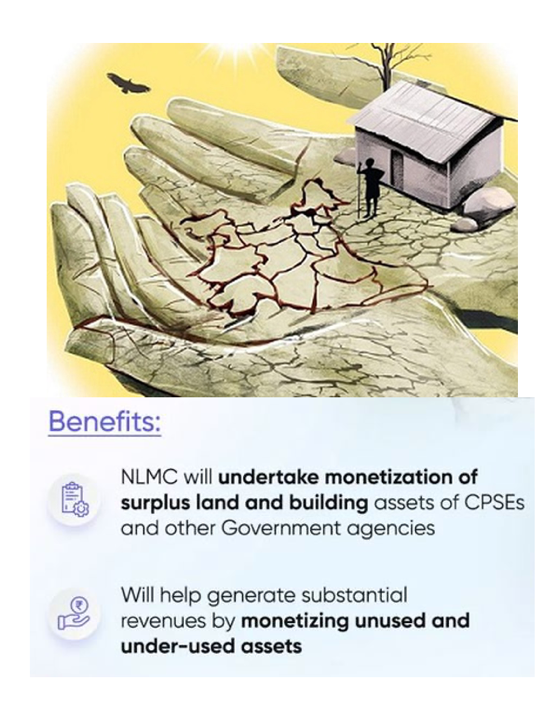
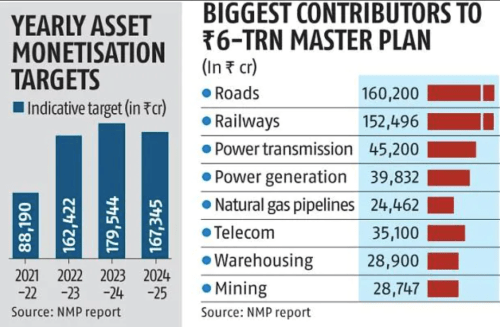
For articles related to the topic, refer:
https://edukemy.com/current-affairs/gazette/2021-09-29/land-monetization
https://edukemy.com/current-affairs/gazette/2021-08-24/national-monetisation-pipeline
https://edukemy.com/current-affairs/gazette/2021-05-28/land-bank-company
https://edukemy.com/current-affairs/gazette/2022-01-12/survey-of-defence-land
Source:
- Source: National Land Monetization corporation: Cabinet clears agency to monetise Govt land
- Cabinet clears body for land monetisation
Image source:
MSME Innovative Scheme
In News
Union Minister for MSME launched the MSME Innovative Scheme (Incubation, Design and IPR) along with the MSME Idea Hackathon 2022.
About the News
- The MSME Innovative Scheme is a combination of existing sub-schemes around incubation, design, and intellectual property rights (IPR) for MSMEs.
- The new scheme would act as a hub for innovation activities facilitating and guiding the development of ideas into viable business propositions that can benefit society directly and can be marketed successfully.
- However, the erstwhile three schemes of incubation, design and IPR will also continue to operate as individual programmes.
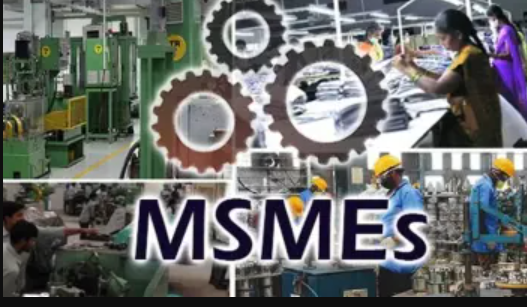
Details of the Scheme
The various sub-schemes included under MSME Innovative Scheme are:
- Incubation:
- The primary objective of the scheme is to promote and support untapped creativity and to promote adoption of latest technologies in MSMEs that seek the validation of their ideas at the proof-of-concept level.
- Financial assistance up to Rs. 15 lakh per idea and up to Rs. 1.00 crore for relevant plant and machines will be provided.
- Design:
- The objective of this component is to bring Indian manufacturing sector and Design expertise/ Design fraternity on to a common platform.
- It aims to provide expert advice and cost-effective solution on real time design problems for new product development, its continuous improvement and value addition in existing/new products.
- Financial assistance up to Rs. 40 lakh for design project and up to Rs. 2.5 lakh for student project will be provided.
- IPR (Intellectual Property Rights):
- The objective of the scheme is to improve the IP culture in India with a view to enhance the awareness of Intellectual Property Rights (IPRs) amongst the MSMEs and to encourage creative intellectual endeavor in Indian economy.
- It also aims to take suitable measures for the protection of ideas, technological innovation and knowledge-driven business strategies developed by the MSMEs for their commercialization and effective utilization of IPR tools through IP Facilitation Centre.
- Financial assistance upto Rs. 5 lakh for Foreign Patent, Rs. 1.00 lakh Domestic Patent, Rs. 2.00 lakh for GI Registration, Rs. 15,000/- for Design Registration, Rs.10,000/- for Trademark in the form of reimbursement.
- The government also announced equity support of up to Rs 1 crore for commercialisation of ideas, designs and patents across all three sub-schemes and also to help MSMEs further scale up to raise subsequent funding. For this, a separate corpus will be created and managed by SIDBI as the fund manager.
For articles related to this topic, refer:
https://edukemy.com/current-affairs/gazette/2021-07-05/technology-innovation-platforms
https://edukemy.com/current-affairs/gazette/2021-09-21/the-global-innovation-index-2021
https://edukemy.com/current-affairs/gazette/2021-12-30/atal-innovation-rankings-2021
https://edukemy.com/current-affairs/gazette/2021-06-16/innovations-for-defense-excellence
Sources:
Fee guidelines for private medical colleges
In News
The National Medical Commission has recently released guidelines for fee structure in Private medical colleges, including deemed universities.
About the News
- From next session private colleges will have to charge fees equivalent to government medical colleges in their states for half of the total approved seats in their institutes.
- At present nearly half of all MBBS seats in India are in government colleges, fees for which are determined either by the central government (for central government-run or autonomous colleges like AIIMS-Delhi) or the respective state governments.
What are the important directives of the new guideline?
- More seats at lower fees: Out of the total 85,000 medical seats in the country, almost half are in 276 private colleges (41,190 seats). The new directive will open about half of these seatse., nearly 20,000 available to students at lower tuition fees determined by the government.
- More opportunity: Nearly 75% of total medical seats will be available at nominal costs to students who missed the government seats by a few marks could not study in private medical colleges because of the high costs, especially in the deemed universities.
- Merit-based system: All admissions will be through merit as students will be granted these seats as per merit in the NEET-UG test. The students will first be given the seats at government medical colleges, their next option would be the seats in private medical colleges (at government determined fees) and then the rest of the private seats.
- Uniform regulation: Earlier there was no control on the fee structure for private deemed universities at all. Their fees were decided by their internal committees. Now, they have also been brought under the ambit of the state regulatory committees.
- Ending arbitrary fees: colleges will not be able to charge any arbitrary fees for the remaining 50% seats. The fee for these seats will be fixed by the state regulatory fee committee.
- Ending caption fees: The guidelines state that no capitation fees can be charged by the medical colleges and the determination of the fees will be on a “not-for-profit” basis.
- Operating cost: The operating cost of the medical college will form the basis for the fee structure. It will now be calculated on the basis of the audit report from the previous financial year. For a new college without an audit report, the fee structure would be calculated on an ad-hoc basis based on the audit of the most recently established medical college in the state.
- Fixed fees: The fee fixed for a student joining the college should remain the same for the entire duration of the study, subject to inflation adjustment.
- Cap on development fees: The medical colleges will also be allowed to charge a development fee that can range between 6 to 15% on operating cost, depending on their previous expenditure and development plans at present and linked to national rank once the ranking system is in place.
- Ban on hospital running cost: No cost of running a hospital associated with the medical college can be included in the student fees.
- Loss making hospitals: For hospital running at a heavy loss, the state fee regulatory committee may allow the college to charge a portion of it from the students for a period of five to seven years.
What are the major issues with the new guidelines?
- More burden on management quota seats: There is an apprehension that if 50% seats are subsidised and offered at fees of government medical colleges, the cost would be passed on to management quota seats.
- Demand supply mismatch: India has a problem of demand and supply with the seats in medical colleges are few and demand is high, which is also the reason for high costs. If the Medical Council allows each medical college to offer more seats it can offset the costs through division.
- Need for PPP model: The cost of medical college hospitals needs to be included in the fee structure as it subsidises treatment cost in hospitals, which brings in more patients. This also helps students learn better. The government should look into a PPP model as an alternative approach.
For articles related to this topic, refer:
https://edukemy.com/current-affairs/gazette/2022-03-03/indian-mbbs-overseas-graduates
https://edukemy.com/current-affairs/gazette/2021-08-03/neets-all-india-quota
Sources:
Sambhaji Maharaj
On 11 March, 1689, Sambhaji Maharaj was killed by Aurangzeb. The eldest son of the celebrated Maratha emperor, Chhatrapati Shivaji, Sambhaji was the second ruler of the kingdom after his father’s death. In his short rule spanning nine years, Sambhaji gained recognition for his valour and patriotism. He continues to be celebrated, particularly in Maharashtra, as the ruler who chose death over conversion. The great warrior king was also known as Chhava and Shambhu Ji Raje. He led the Maratha army in 1672 for the first time in the battle of Kolwan. The war was between the Mughal and Maratha empires that resulted in the defeat of the Marathas.
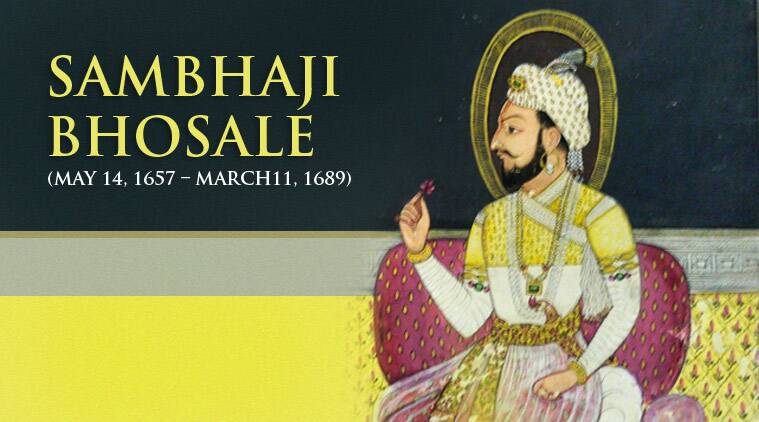
Sources:
Pharma Sector in India
In News
The Jan Aushadhi week was observed from March 1 to March 7 to create awareness about the usage of generic medicines and benefits of Jan Aushadhi Yojana.
About the News
- As of now, more than 8,600 Jan Aushadhi stores are present across the country spanning almost every district, to make medicines affordable and accessible to the citizens.
- Pradhan Mantri Bhartiya Janaushadhi Pariyojana (PMBJP) was launched by the department of pharmaceuticals, ministry of chemicals, and fertilizers in November 2008. Under the scheme, as per the ministry, dedicated outlets known as Janaushadhi Kendras are opened to provide generic medicines at affordable prices.
About the Pharma sector in India
- International Standing: India ranks 3rd in terms of pharmaceutical production by volume and 14th by value. India is a large-scale provider of generic drugs globally and serves to the 20% of global generic medicine demand.
- 80% of the Anti-Retro-viral drugs are sourced from India. India was a substantial producer of vaccineseven before COVID pandemic and controlled more than 50% of the global supplies.
- Domestic Standing: The domestic pharmaceutical industry includes network of around 3,000 drug companies and approximately 10,500 manufacturing units.
- FDI in Pharma: The 200% growth in FDI in pharmaceutical sector during 2020-21 has been followed by a 53% rise during April-September 2021-22.
- Since 2000-2019, the Pharma sector alone contributed to the FDI inflows worth $16.2bn and it increased even more during the COVID-19 pandemic.
- Economic Standing: Bio-Pharma is the largest sectorin India which is contributing to 62% of the total revenue. Economic Survey 202—21 has acclaimed the Pharma sector as one of the top 5 sectors which have reduced the trade deficit of India.
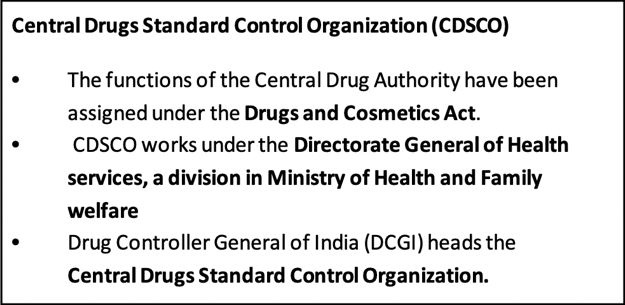
Opportunities in the Pharma sector for India
- Indian pharma industry is expected to reach $65 bn by 2024, and with a growth rate of 10-12% and 7% year on year export growth.
- It will help in increasing medical tourism as this sector has the potential of providing Quality services at marginal costs compared to US, Europe, and South Asia.
- Biopharmaceuticals, bio-services, bio-agriculture, bio-industry, and bioinformatics constitute India's biotechnology industry. The Indian biotechnology industry was valued at US$ 64 billion in 2019 and is expected to reach US$ 150 billion by 2025.
- India’s medical devices market stood at US$ 10.36 billion in FY20. The market is expected to increase at a CAGR of 37% from 2020 to 2025 to reach US$ 50 billion.
- As of August 2021, CARE Ratings expect India's pharmaceutical business to develop at an annual rate of ~11% over the next two years to reach more than US$ 60 billion in value.
What are the Challenges faces by the Pharma sector?

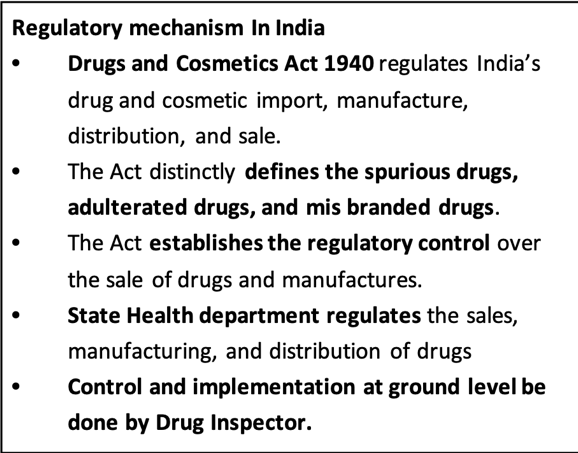
Government Efforts to support the Pharma Sector
- The government has allowed the 74% FDI in brownfield pharmaceutical projects and 100% FDI in Greenfield pharmaceutical projects.
- The government had launched the Pharma Vision 2020, with the following objectives
- Transform India into a global leader in end-to-end drug discovery and development, low-cost of generics. Make India one of the top 5 pharma innovation hubs in the world.
- Recently the Union Cabinet approved the establishment of mega ‘Bulk Drug Parks’ in association with the state governments. These parks will have common facilities like effluent treatment, solvent recovery, distillation, etc.
- The Cabinet also approved the ‘Production Linked Incentive Scheme’ for encouraging the domestic manufacturing of drug intermediaries.
Way Forward
- Focus on R&D and innovation: Indian pharmaceutical industry would need to move up the value chain and focus on innovation which accounts for 2/3rd of the global pharmaceutical market size. The Indian pharmaceutical industry needs to build a strong innovation pipeline (with 5-7 new molecular entities and 10–12 innovation launches per year by 2047).
- Foster policy reforms: A fundamental enabler for a vibrant innovation ecosystem is a strong and efficient regulatory setup e.g., having a ‘single window system’, elimination of multiple regulatory bodies, establishing detailed guidelines.
- Digital transformation: Digital transformation is imperative for improved patient care, cost-effectiveness, greater transparency, improved production, and drug development. Supply chains are also becoming more patient-centric due to the increased adoption of digital tools, telehealth, and app-based ecosystems.
- Nurture valuable collaborations: During COVID 19 pandemic, cohesive collaboration between the government, academia, and industry to promote research initiatives has been the key. Regular feedback, integrated efforts, sharing and consistent dialogue between industry stakeholders and government authorities has worked well during COVID-19 pandemic and this dialogue should continue in future too.
- Focus on exports: Going forward it will be critical for the industry to consolidate the existing large export markets and to explore new ones. Indian missions abroad could be great facilitators in this context. At the same time, the policies in India would need to focus on supporting the industry to be competitive in the export market through policy instruments such as Remission of Duties and Taxes on Exported Products (RoDTEP), PLIs, incentivising R&D and innovation in the pharma sector.
For articles related to this topic, refer:
https://edukemy.com/current-affairs/gazette/2021-11-22/pharmaceutical-sector-in-india
https://edukemy.com/current-affairs/gazette/2022-01-28/conditional-market-authorisation
https://edukemy.com/current-affairs/gazette/2021-09-30/intellectual-property-rights-regime-in-india
Question: India’s pharma industry sector faces many hurdles despite its huge success. Discuss.
Sources:
CHACE-2
This is image of the Chandra’s Atmospheric Composition Explorer-2 (CHACE-2) mass spectrometer on Chandrayaan-2. CHACE-2 is an equipment onboard India’s 2017 Chandrayaan-2 orbiter has made new observations about the distribution of an important gas in the moon’s upper atmosphere, which can offer new insights into the lunar surroundings. The new data shows the distribution of Argon-40 gas in the lunar ‘exosphere’, beyond the areas this was known to exist. Though, Argon-40 (Ar-40) is known to exist in the lunar exosphere, the knowledge on its distribution at higher latitudes is lacking. For the first time, Chandra’s Atmospheric Composition Explorer-2 experiment aboard Chandrayaan-2 orbiter has continuously observed Ar-40 in latitude range of -60 to +60 degrees. The observed global distribution indicates that the interaction of Ar-40 with the surface is similar in low and mid latitude regions.
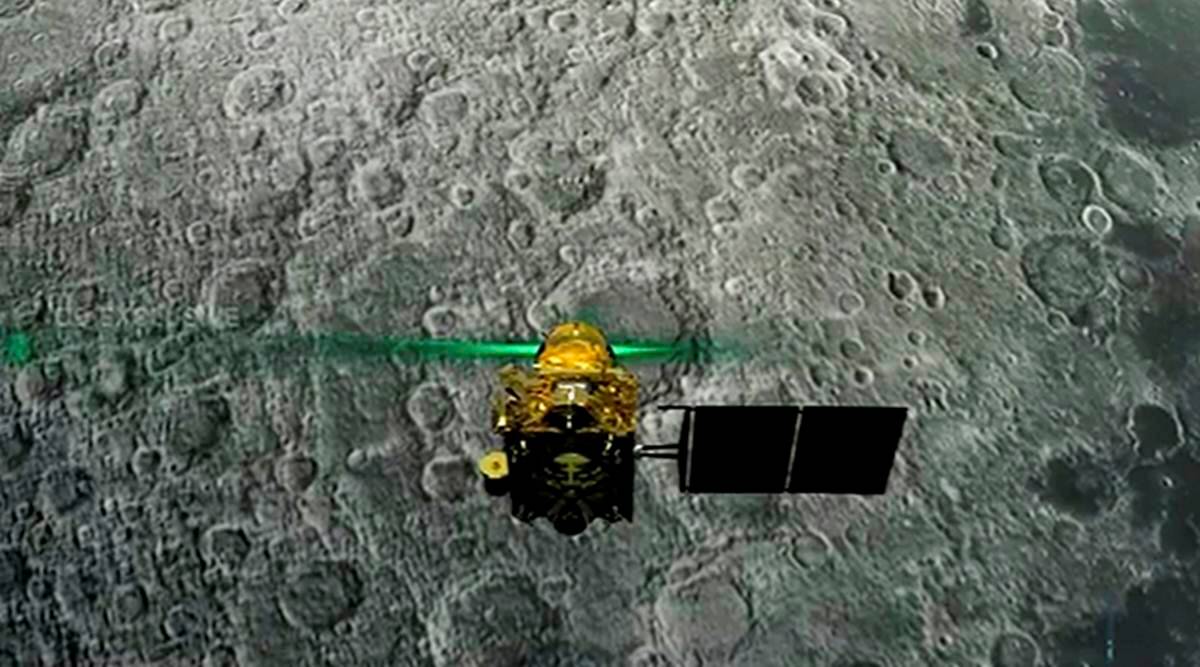
Source:
Dharma Guardian
- Context: Exercise Dharma Guardian has recently concluded at Belgaum.
- Dharma Guardian is an annual bilateral military exercise between India and
- The exercise aims to develop mutual understanding and respect between militaries of both countries, and to facilitate tracking of the worldwide phenomenon of
- The first edition of the exercise was held at Counter Insurgency Warfare School of the Indian Army at Vairengte in
- In the recent edition, both contingents not only shared their expertise on contemporary subjects of counter-terrorism operations, but also utilised this opportunity to share their experiences on exploiting disruptive technologies like drone and anti-drone
- The exercise also provides a platform for professional and cultural learning as well as social interactions.
- This in-turn broadens the horizon towards knowledge and cooperation aiming towards co-existence as one in the Indo-Pacific Region.
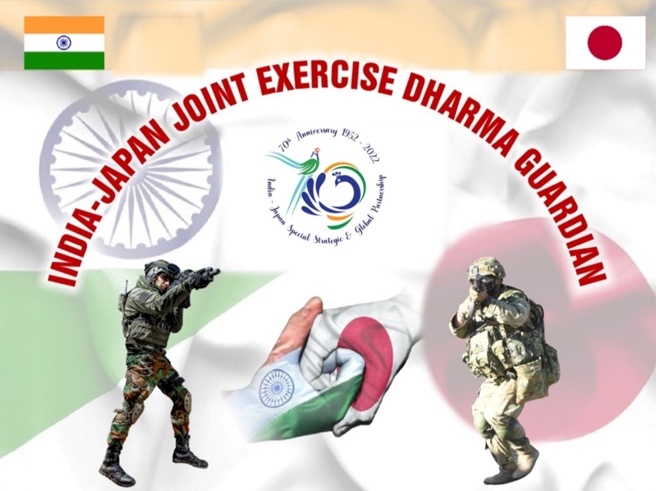
Source:
- India, Japan Army exercise concludes in Belgaum
- Annual Indo-Japanese defence exercise Dharma Guardian concludes
Image source:
WHO Traditional Medicine Centre
- Context: The Union Cabinet has recently approved the establishment of a WHO Global Centre for Traditional Medicine (WHO GCTM) in Jamnagar, Gujarat.
- This would be the first and only global outposted Centre (office)for traditional medicine and is set up under the Host Country agreement signed between GOI and WHO.
- It is an initiative that will aid India in positioning traditional medicine across the globe and will be established under the Ministry of Ayush.
- Traditional medicine is a key pillar of health care delivery systems and plays a crucial role in maintaining good health and well-being.
- Safe and effective traditional medicine ensures accessible, effective and affordable essential medicines as the world approaches the ten-year milestone for Sustainable Development Goals in 2030.
- In this regard, WHO GCTM would emerge as a centre of global wellness, bolstering evidence –based research, training and awareness for Traditional Medicine.

Source:
- In a first, India to get WHO traditional medicine centre in Gujarat
- Cabinet approves establishment of WHO Global Centre for Traditional Medicine in India
Image source:
E-invoicing
- Context: E-invoicing has been a blessing in disguise helping businesses in managing their operations remotely as well as compliance procedures seamlessly of late.
- Electronic invoicing (e-Invoicing) is the exchange of the invoice document between a supplier and a buyer in an integrated electronic format.
- Traditionally, invoicing, like any heavily paper-based process, is manually intensive and is prone to human error resulting in increased costs and processing lifecycles for companies.
- Thus E-invoicing benefits businesses in the following ways:
- Reduces the possibility of human errors
- Minimizes the chances of fraudulent transactions
- Enhances seamless cash flow management
- Enables remote working and management
- Easy loan accessibility
- Benefits the government by enabling the ease of doing business.

Source:
- How e-invoicing is simplifying compliances for small businesses and helping in managing businesses remotely in India
- e-invoicing under GST. What is it and its applicability and implementation?
Image source:
Ship ‘Endurance’ 100 years beneath Antarctic Ice
- Context: The Endurance, the lost vessel of Antarctic explorer Sir Ernest Shackleton, has recently been found at the bottom of the Weddell Sea,
- The ship was crushed by the Antarctic sea-ice, and it sank to about 10,000 feet (3,000 m) below surface of the ocean in
- Despite being stranded on the ice, the 28-man crew of the “Endurance” made it back home alive, and this has been considered one of the greatest survival stories of human history
- The project to find the lost ship was mounted by Falklands Maritime Heritage Trust (FMHT) using a South African icebreaker, Agulhas II, and equipped with remotely operated submersibles.
- The wreck itself is a designated monument under the international Antarctic Treaty and this means that it must not be disturbed in any way.
- Therefore no physical artefacts have been brought to the surface.

Source:
- Shackleton’s ship ‘Endurance’ found beneath Antarctic ice, 100 years on
- Endurance: Shackleton's lost ship is found in Antarctic
Image source:
Make trade deals for Make in India: FE
Essence: The article is trying to bring attention on the trade negotiations held by India with various countries. India while negotiating should ensure that the trade agreements should improve the inflow of capital rather than inflow of goods in India. Government has laid out schemes like Phased Manufacturing Programs (PMP) and Production Linked Incentives (PLI’s) to encourage investment in India. However, the benefits under these initiatives are not that lucrative for the companies to set up their manufacturing units in India.
Also, India needs to find a way via which it can enforce the commitments and honoring of agreement by the parties. Although mechanisms to solve any dispute exist under FTA’s, but places where the entities are of different sizes and economic power, resolution could be little difficult. So, a holistic view of government schemes on investment and trade governance is necessary as that would decide future negotiations.
Why should you read this article?
- To understand what the ongoing trade negotiations should focus on.
- To understand various trade deals by India.
- To understand various initiatives that has been taken by government to support Make In India.
- To understand certain areas that needs to be revisited in the laid-out schemes.
Source:
Can India’s Defense Industry Make It On The Export Market: ORF
Essence: The editorial talks about the prospects and constraints of defense industry and export targets of $5Bn by 2025 that it is supposed to meet. The BrahMos supersonic cruise missile deal with Philippines provides hope for its export to Vietnam and Indonesia as well. India’s defense exports have risen from @275 million to $1.13 billion between 2016 to 2021.
But the challenges persist in the multiple forms- limited government funding, research and manufacturing, small fraction of exports by public sector (10%). The finances spent on procurement from domestic sources are high, leading to less focus on exports. The PSUs aren’t efficient and don’t have a brand value in international market (time and cost overruns). Eg the failed sale contract of HAL’s ALH by Ecuador. The ship building industry is said to be unsuitable configured or too expensive to strike a trade deal and similar is the condition of ammunition consumable industry.
The Brahmos deal gives a ray of hope to start exporting Pinaka, Akash, Tejas and create a brand value in times to come. However, India will need fiscal and industrial reforms to achieve the export growth targets.
Why should you read this article?
- To understand the present level of private and public sector participation in defense exports.
- To know the shortcomings in India’s defense industry.
Source:
Farming as a Service (FaaS) in India: HBL
Essence: While the importance of technology for farmers was never in doubt, its affordability for small farmers was always limiting its success. Farming as a Service (FaaS) is emerging as a panacea for such farmers in India. It enables farmers to use equipment by paying for its fees without worrying about equipment breakdown and other losses. FaaS start-ups connect farmers and equipment owners to address the market opportunity for mutual benefits.
While reach of FaaS is limited at present to few states only but once scaled it promises to lead to sustainable food production.
Why should you read this article?
- To know about Farming as a Service (FaaS), an emerging agritech solution.
Source:
Kanya Taru Yojana
Background
On the occasion of the International Day of Girl Child, Keerthi Jalli, the Deputy Commissioner of Hailakandi formally launched the Kanya Taru Yojana.
About the Initiative
- As per the initiative, fruit-bearing trees will be distributed to the mothers of girl child who gave birth in the government hospitals.
- The rationale behind fruit bearing trees is to facilitate the mindset among the pregnant and lactating mothers to eat fruits and vegetables for a healthy diet.
- The importance of giving trees to the families of a girl child is to encourage them in nurturing their daughters by providing nutritional food.
- The trees will named after the new-born daughters to keep the emotional conditioning
- All logistics and procedures are taken up by the government bodies for smooth implementation of the scheme.
- This scheme will not only provide nutritional literacy but will give a massive boost to the afforestation
- Later, the initiative will cover the boy child as well.
Quote: “When women are able to live in a safe and secure environment, they can participate effectively in the economy and society. This helps overcome poverty, reduces inequalities and is beneficial for children's nutrition, health and school attendance. Every woman and girl has the right to live in safety in her home and community.” - Helen Clark

Source:
Image source:
Share the article
Get Latest Updates on Offers, Event dates, and free Mentorship sessions.

Get in touch with our Expert Academic Counsellors 👋
FAQs
UPSC Daily Current Affairs focuses on learning current events on a daily basis. An aspirant needs to study regular and updated information about current events, news, and relevant topics that are important for UPSC aspirants. It covers national and international affairs, government policies, socio-economic issues, science and technology advancements, and more.
UPSC Daily Current Affairs provides aspirants with a concise and comprehensive overview of the latest happenings and developments across various fields. It helps aspirants stay updated with current affairs and provides them with valuable insights and analysis, which are essential for answering questions in the UPSC examinations. It enhances their knowledge, analytical skills, and ability to connect current affairs with the UPSC syllabus.
UPSC Daily Current Affairs covers a wide range of topics, including politics, economics, science and technology, environment, social issues, governance, international relations, and more. It offers news summaries, in-depth analyses, editorials, opinion pieces, and relevant study materials. It also provides practice questions and quizzes to help aspirants test their understanding of current affairs.
Edukemy's UPSC Daily Current Affairs can be accessed through:
- UPSC Daily Current Affairs can be accessed through Current Affairs tab at the top of the Main Page of Edukemy.
- Edukemy Mobile app: The Daily Current Affairs can also be access through Edukemy Mobile App.
- Social media: Follow Edukemy’s official social media accounts or pages that provide UPSC Daily Current Affairs updates, including Facebook, Twitter, or Telegram channels.


